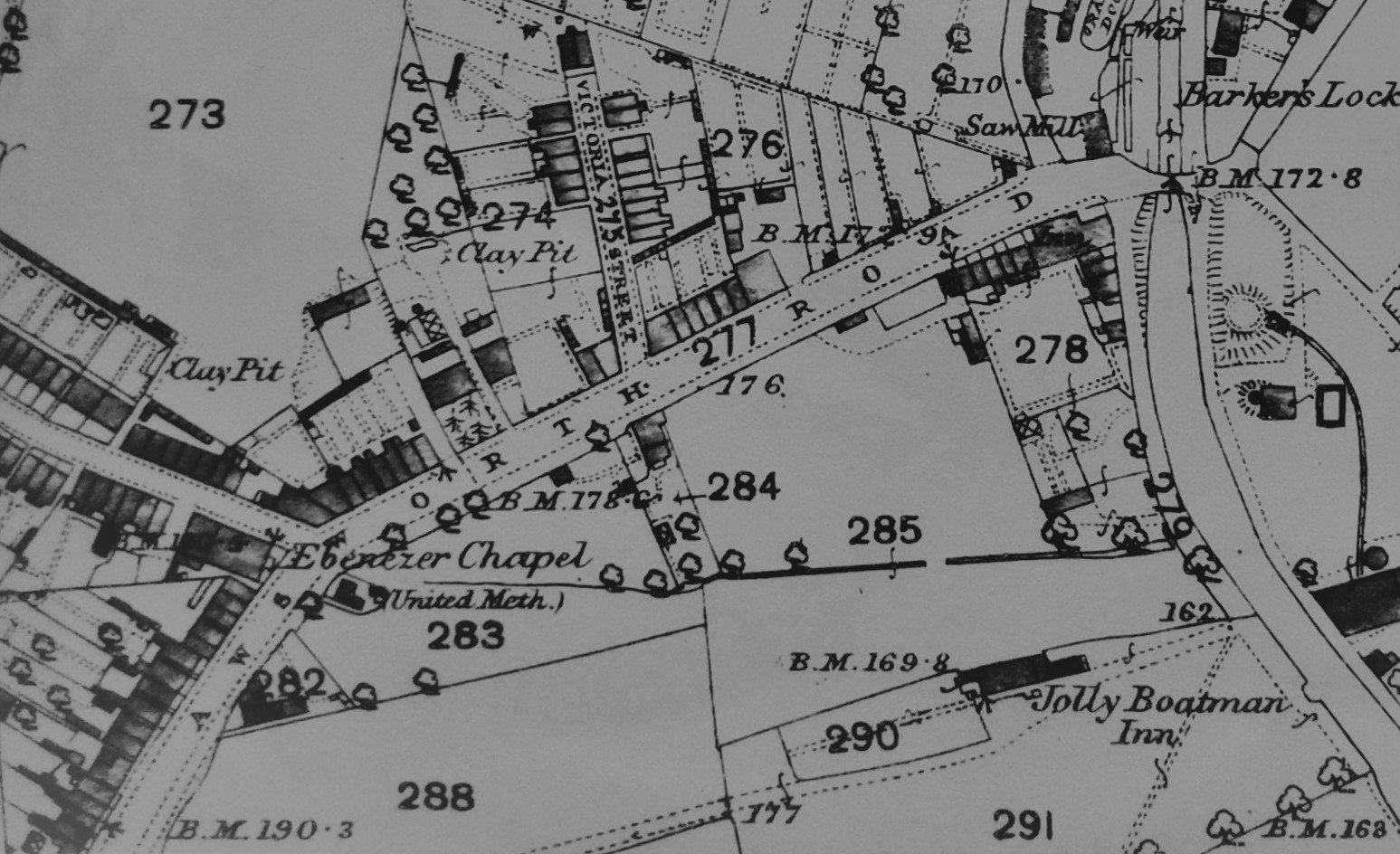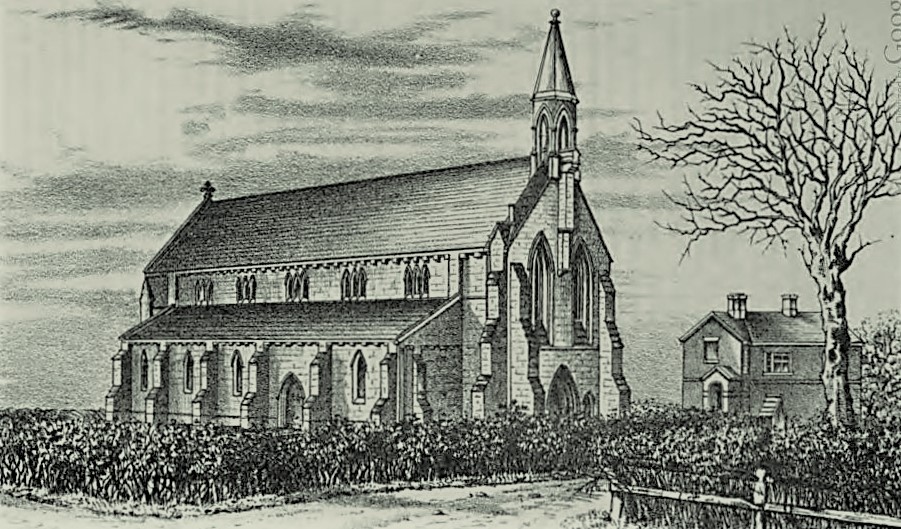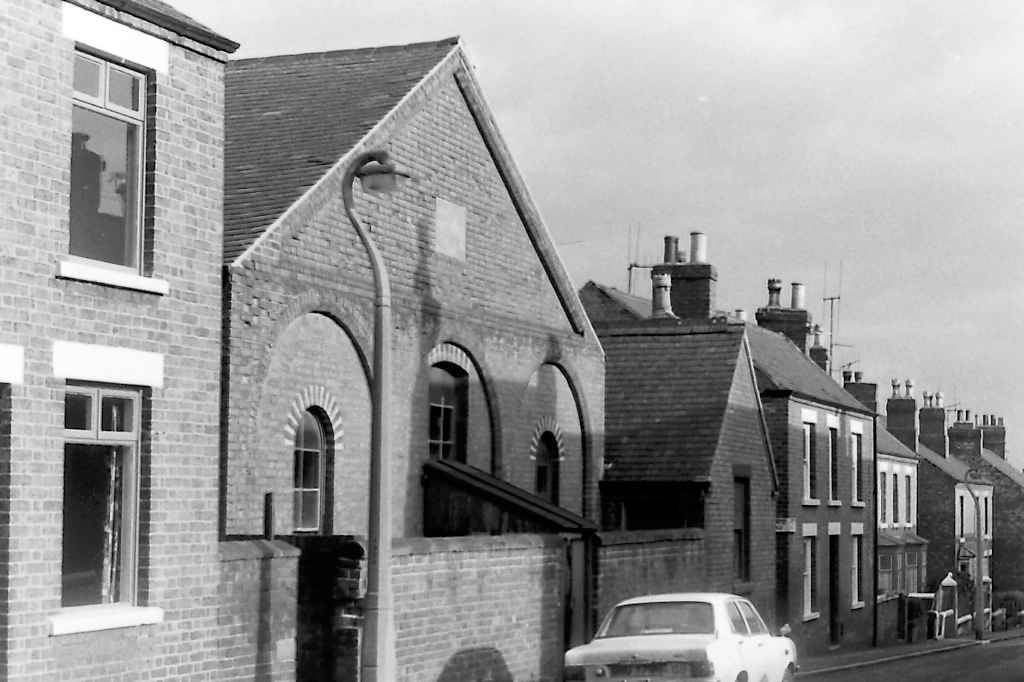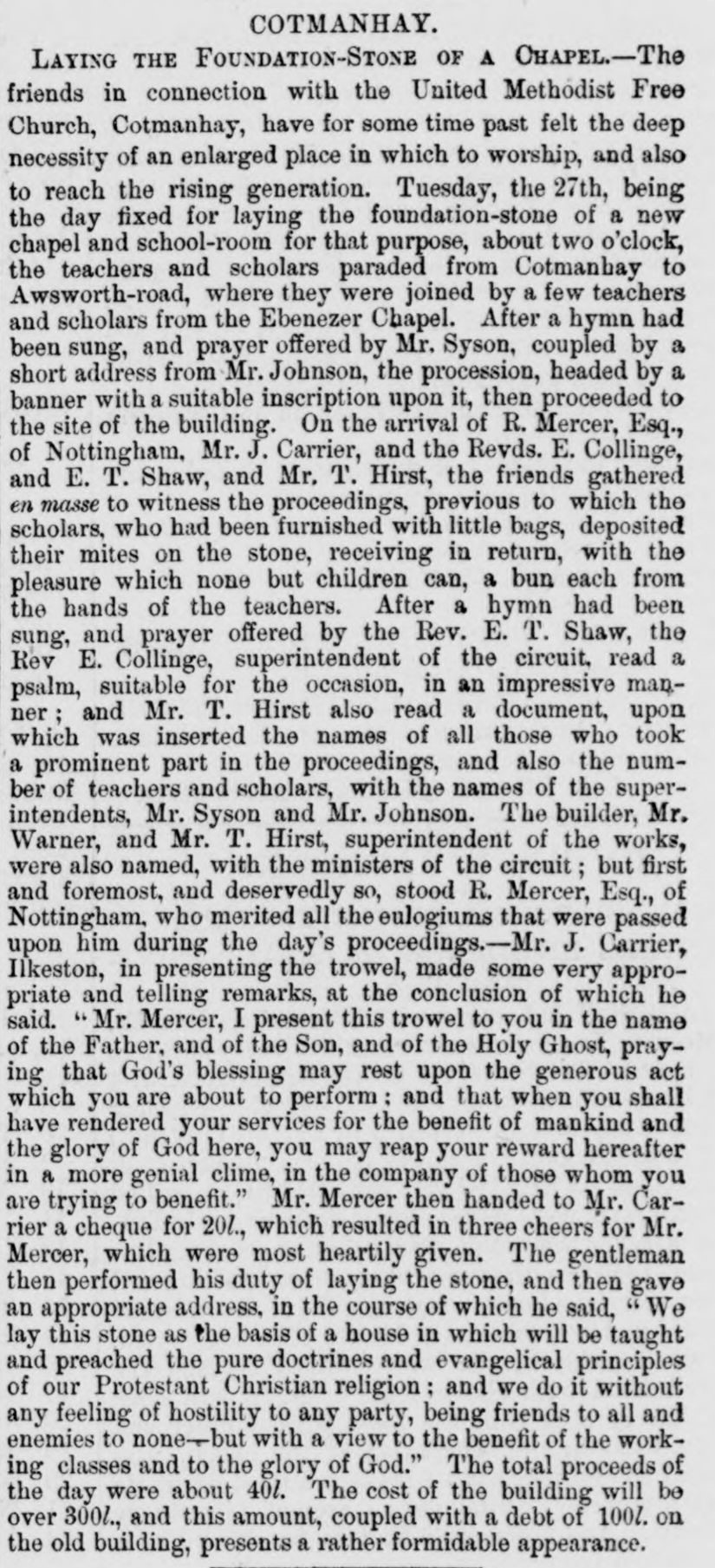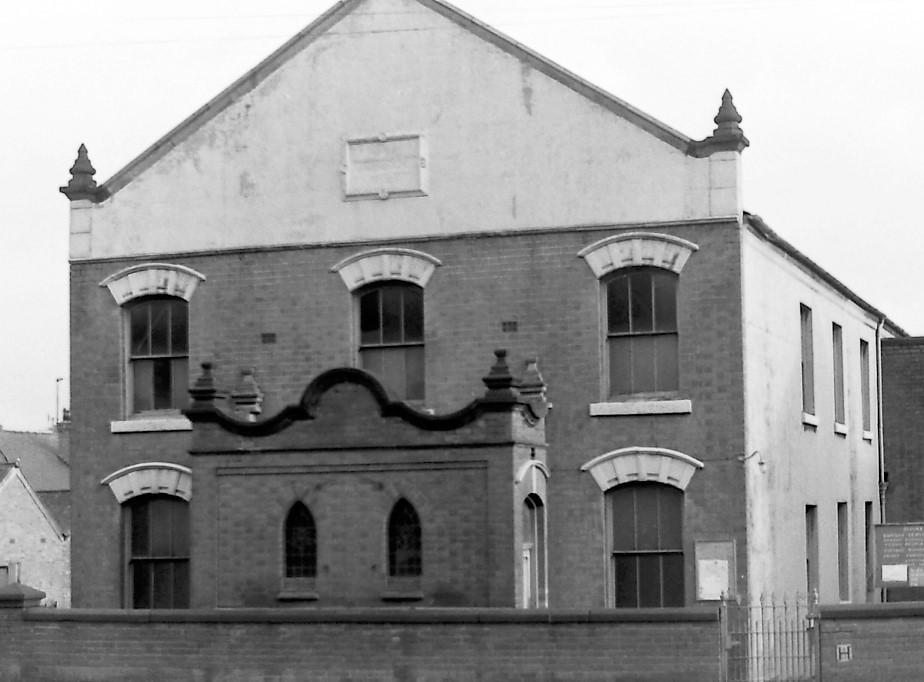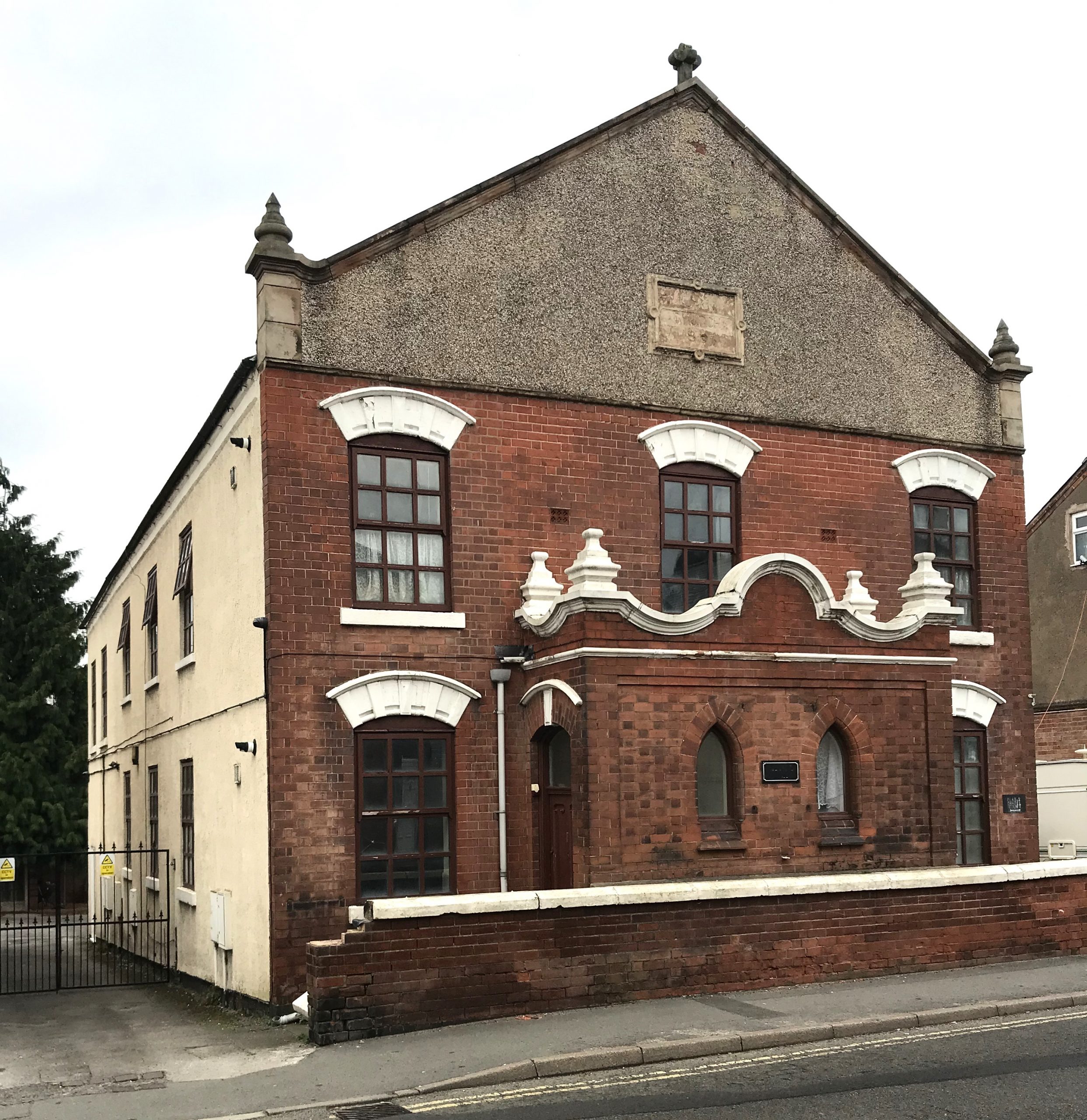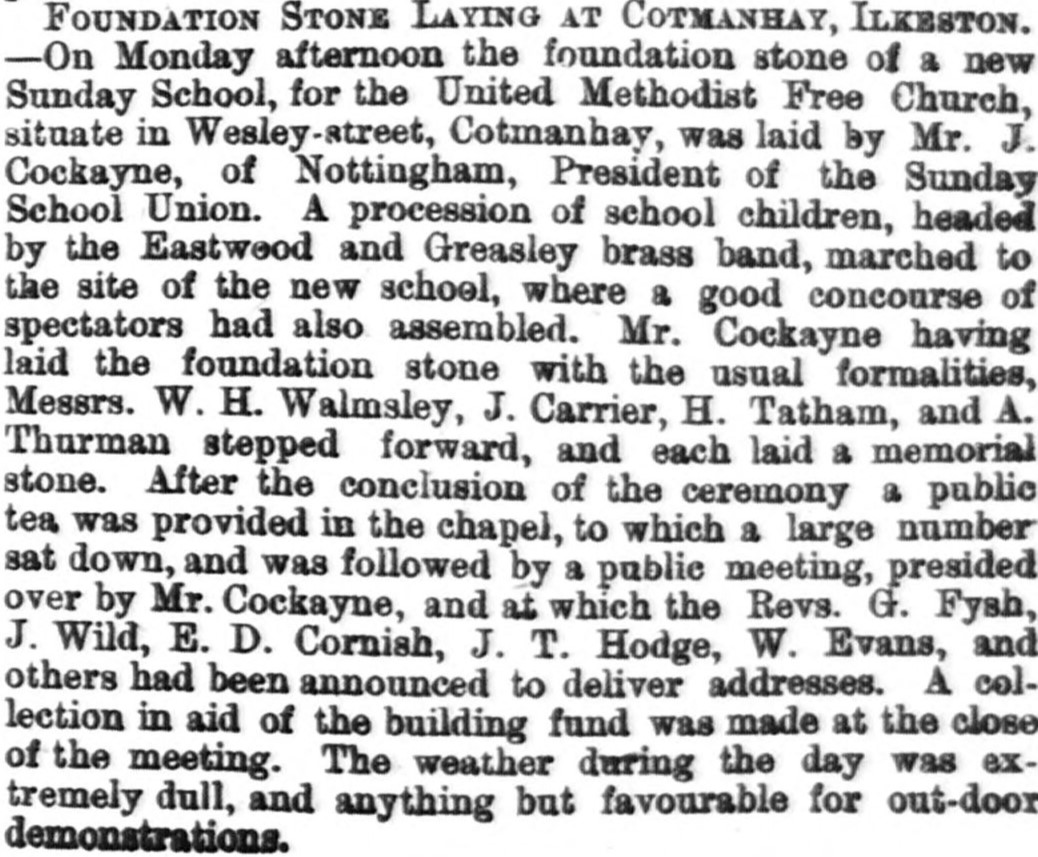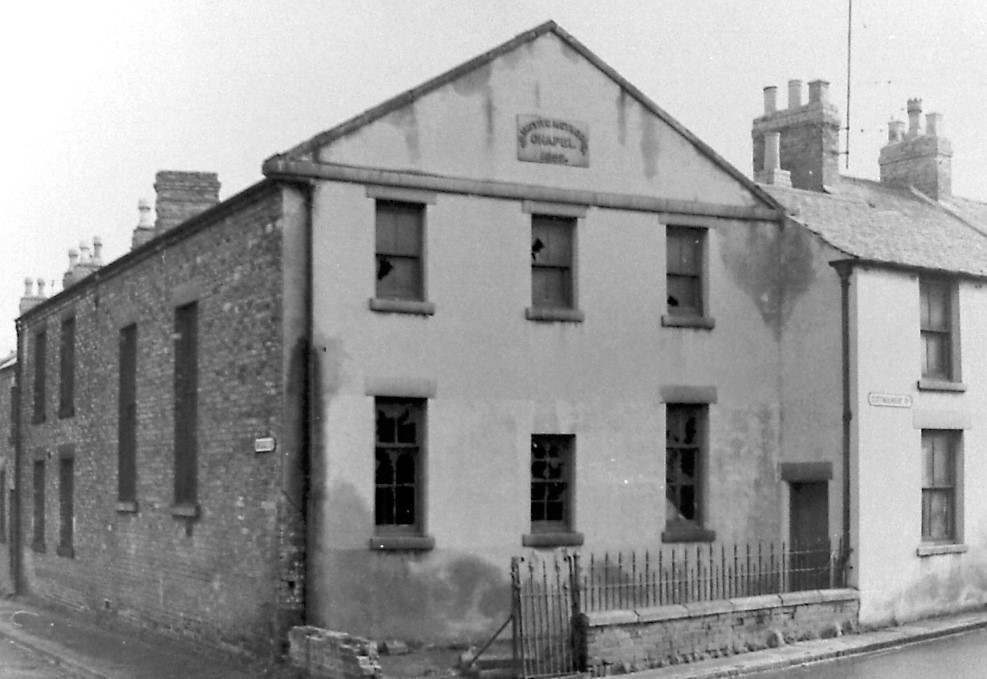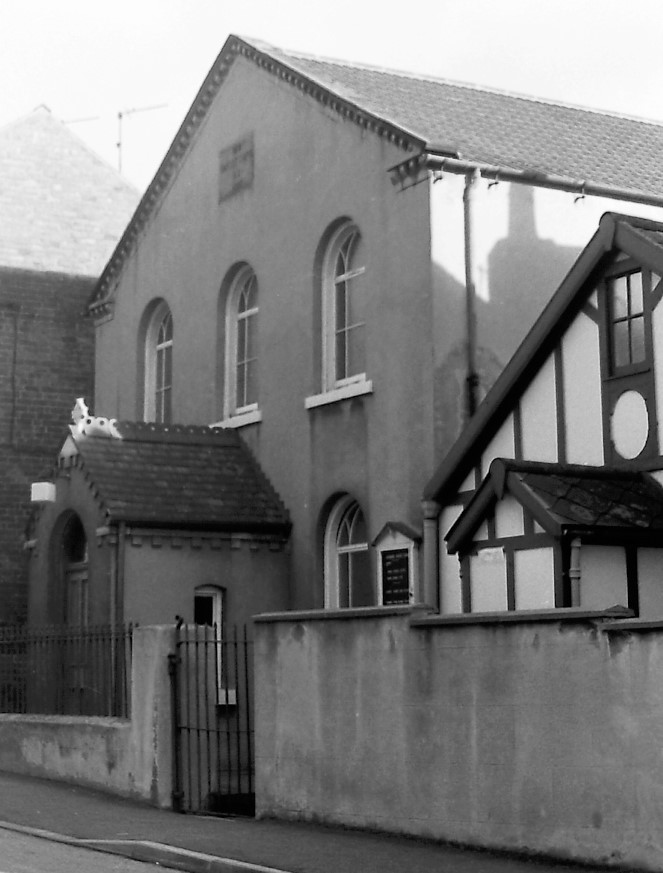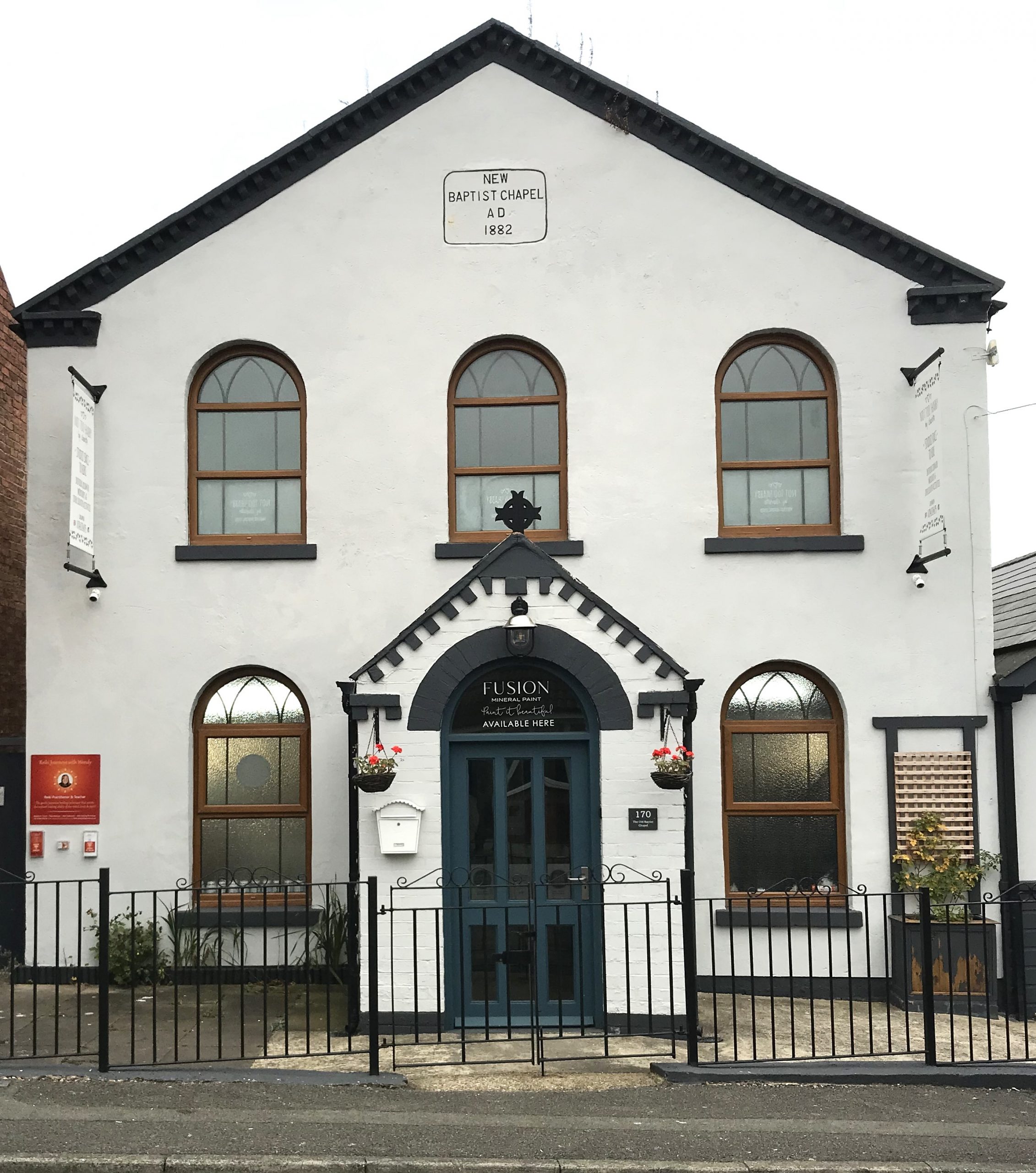Old and new
On Ilkeston Common we find the Wesleyan Methodist Chapel known as the Ebenezer Chapel — built in 1853 and sharing its biblical name with the adjacent Ebenezer Street, where it stood, at the corner of Awsworth Road. But was there a Wesleyan chapel on the Common or in Cotmanhay before this one, and if so, where ??
The site of Ebenezer Chapel in c1880
The old chapel 1806-1853; Where was it ?
When we were visiting South Street with Adeline, we saw how the Wesleyan Connexion had long been struggling with internal conflict, and how serious disagreements had erupted in the 1840s, disagreements which resulted in major divisions within the Wesleyan community. Various factions were formed at that time, one of which was the “Wesleyan Reformers“.
In 1846 Bagshaw’s Directory of Derbyshire pointed out, somewhat vaguely, that in Cotmanhay “the methodists have a chapel, erected 1806, to seat 400 persons, with a sunday school of 120 children“. Subsequent directories identified this chapel and its school as belonging to the Wesleyans.
Then the Religious Census of 1851 gave a little more detail about this chapel. It was a separate building, 10 yards by 8 yards, for the exclusive use of the Reformers (as opposed to a room or premises rented by them and used by others too). It now had 140 free seats, 75 other seats, and 60 standing spaces, attracting an evening congregation of over 100. In its Sunday School over 130 pupils were attended by 10 teachers.
This census couldn’t be referring to the new Ebenezer Chapel which hadn’t been built by 1851. I believe that the chapel mentioned in the census stood in Wesley Street. (see later, below)
A new chapel 1853
In autumn, 1852, work was begun on the new Wesleyan Reform chapel on the Common (Awsworth Road) when the foundation stone was laid there by the Rev. James Everett. The building, 33 feet by 21 feet, had been suggested by Mr. Richard Evans of Ilkeston Pottery on land owned by him, and was eventually opened on Sunday, January 23rd, 1853.
In his diary of the time, John Cartwright records the first days of this new chapel. With her friends, his sister Martha was helping in the preparations for the grand opening of the building, which was ‘situated on Ilkeston common by the hot-water course running from the colliery pumping-engine higher up’. The Rev. J. Youngman (afternoon) and Mr. Seth Peace (evening) led the congregation for the first services and there were full houses, with many standing and others being turned away.
“The clear, honest, original, exposition of New Testament doctrine and usage by Mr. Youngman, and the warm-hearted and soul-saving influence that accompanied Mr. Pearce’s(sic) devotional exercises, were productive of great good” (NR January 1853)
A tea meeting at the new chapel on the following Monday evening was attended by about 250 people — at two sittings!!.
This was followed by ‘ a most animated, social and instructive public meeting, on the value of Sunday school tuition, in connection with the preaching of the gospel’, presided over by Henry West and during which one of the speakers was John Columbine. The collection on Sunday and the proceeds of the tea meeting totalled more than £30.
Adeline remembers this chapel well, although she was born in the year following its opening. She writes ….
“Ebenezer Chapel, on the Common, has very interesting memories for me. As a child I often accompanied my father when he was appointed to preach there. The chapel was a commodious room with forms for the congregation.
“I remember going one Sunday afternoon to the chapel. A young man, a probationer for the teaching plan, was to preach his trial sermon, and my father was deputed to attend, and give a report to the committee. William — not his real name — opened the service very well indeed, then gave out his text, and began to preach. After a few minutes he stopped, looked round the chapel, and then laying his hands on the Bible, put his head on them. It was a tense moment. The congregation sat perfectly still, but my father, without any hesitation, went up, spoke a few quiet words to William, placed him on the pulpit seat, and then finished the service.
“I have never forgotten that incident. William was encouraged to try again, and was successful”.
“The neighbourhood…. was perhaps more neglected than any part of the town, for young men in their teens attended the (Sunday) school, and what they there learnt, along with the writing class held on Monday evenings, was all the education many of them received.
“So ill-informed were some of the scholars that the superintendent said, on one occasion, they reminded him of a lad being attended by a doctor, and being told to put out his tongue.
“The lad gazed at the doctor, not understanding him, upon which the lad’s mother told him to open his goblet and put out his lollypop, which the doctor at once examined”. (Bullock-(H)edge Nook 1893: this pseudonym was chosen by the writer as Bullock Hedge Nook was close to Ebenezer Chapel though I haven’t been able to locate it accurately).
After 1853
In 1857 the Wesleyan Reformers amalgamated with the Wesleyan Methodist Association to form the United Free Methodists. This is the name attached to this Ebenezer chapel which you see on the 1880 map (above). As you can see this Free United Methodist chapel, seating 750, was on the south corner at the junction of Ebenezer Street with Awsworth Road, and had its adjoining Sunday School on its west side. It was replaced by new church and school on the same site in 1872.
By 1857 White’s Directory was informing us that, at Cotmanhay. “the Wesleyan Reformers .. have … a chapel … “. This would be the Ebenezer Chapel, described above, and from that year, was part of the United Free Methodist Movement. It was replaced in 1872 by a new church and Sunday School on the same site.
The existence of this new chapel was also recorded in other directories up to the 1880s when Wright’s Directory of 1883 added that there was ” a chapel on Awsworth Road” and helpfully mentions the date of 1872. However this vague description might suggest that it is unsure whom it belongs to; by 1885 the same directory is now aware that it is a “Methodist Free Church“. Little extra information about this property was offered up to the end of the Victorian era.
( A new Ebenezer Church was opened in 1936 on the north corner of Charlotte Street and Heanor Road, after fundraising which had begun in 1919 !!! The building is no longer a church)
———————————————————————————————————————————-
Other religious meeting places in Victorian Cotmanhay
In the local trade directories of the 19th century, it wasn’t until about 1846 that Cotmanhay had its own description, separate from Ilkeston, after the formation of a new ecclesiastical district in March of that year. And Christ Church of Cotmanhay and Shipley was the first C of E Church for this new district.
Christ Church, Cotmanhay
Christ Church in Cotmanhay hadn’t been erected by 1846, though it was noted by Bagshaw’s Directory that “a district church is about to be erected“. This proposed new church building already had a site, donated by the Duke of Rutland, and subscriptions were now being taken, while a grant of £570 was received from the Lichfield Diocesan Church Extension Society.
By September 1846 a Committee of Mangement had been formed to oversee and augment the fund for this church. The target was £2100 and although the total, so far, was short of that amount it was sufficient to enable the committee to give the architect instructions to apply for building tenders. The chosen tender was that of James E Hall of Nottingham. reflecting a total cost of £2200 (without the restorations)
The plans impressed the Committee, “showing the great professional taste and ability of the architect, Mr. (Henry Isaac) Stevens” though some exterior ornamental stone work and interior decorations had initially been cancelled, to cut costs. This ‘downgrading’ hadn’t pleased several members of the committee; Squire Mundy, the Rev. Ebsworth, the incumbent of the new parish, the Rev Symons, and a few others, all dug deep into their pockets and came up with donations to cover the costs of restoring many of the ornaments and decorations.
On April 26th, 1848 Christ Church, Cotmanhay was solemnly consecrated to its holy uses by the Lord Bishop of Lichfield. As the Derby Mercury described it (May 3rd. 1848):
“It is of the first pointed style, and consists of a nave with aisles, and a small bell turret on the western gable. There is unfortunately no chancel; but the eastern window — a handsome triple lancet — being placed within an arch of construction, this necessary portion of a Christian temple may be added at a future time.
“The church is divided into fine bays by circular columns and pointed arches. The interior arrangements are for the most part exceedingly good, and the effect is ecclesiastical and solemn. The santuary is elevated on three steps and surrounded by very neat rails; but the alter should have a foot place, as at present it is almost hidden. The seats are all open, massive, and convenient for kneeling. The centre avenues are of ample width; a circumstance which adds much to the effect of the high pitched open roof. The font, which is a stone one, is appropriately and correctly placed near the west door.
“The church has been erected by Mr. J. E. Hall of Nottingham, from the designs of Mr. H. I. Stevens of Derby; at a cost of about £2500”
Wesleyan Methodist Chapels
We have seen the that the Wesleyan Reformers/United Free Methodists had their Ebenezer Chapel on the Common since 1853. But what about the original Wesleyan Chapel in Cotmnahay, built in 1806 and suggested to be on Wesley Street ?
The site of the Wesley Street chapel and Sunday school, built in 1877 (photo taken by Jim Beardsley in the mid 1970s)
It seems that a chapel in Wesley Street was still in use, at least until 1867, when the foundation stone of a new chapel was laid. This was on August 27th, at a site in Cotmanhay Road, opposite Wesley Street, as the Derby Mercury reported on August 4th, 1867.
The congregation then moved there although the Sunday school remained in Wesley Street. The building survives today, though no longer a chapel
Here are two views of this 1867 United Free Methodist Chapel, seating 400, standing opposite where Wesley Street joins Cotmanhay Road.
This wasn’t an end to the Wesleyan building in Cotmanhay. Ten years after the new chapel had opened in Cotmanhay Road, a new Sunday School building attached to the former Wesley Street chapel was designed and built.
from the Nottinghamshire Guardian (April 13th, 1877)
So, by 1880 the United Free Methodists had two chapels in the Cotmanhay area — one on Awsworth Road (their Ebenezer Chapel) and now one on Cotmanhay Road.
Primitive Methodist Chapels
In the first half of the 19th century the Primitive Methodists of Cotmanhay initially had a ‘room‘ there, with no exclusive claim on its use and certainly not a separate chapel. In the early 1820’s, initiated by the evangelical work of Sarah Kirkland, regular services were held in the houses of Job Fretwell at Cotmanhay and Hannah Wheatley at Shipley. Probably because these premises were proving too small, services moved to a barn belonging to the Ancient Druids Inn on Cotmanhay Road, (a forerunner of the Primitive Methodist Chapel at the corner of Bridge Street and Cotmanhay Road).
The 1851 Religious Census recorded a very small congregation with an average attendance of 35 to 40.
However in 1853 a Primitive Methodist Chapel was constructed at the south corner of Bridge Street and Cotmanhay Road. This was just a year after the “Prims” had successfully built their chapel in Bath Street.
It was closed in 1958.
The Baptists in Cotmanhay
A “New Testament Disciples’ chapel (Baptist)” was built on Norman Street (North) in 1882.
———————————————————————————————————————————-
The Mutual Improvement Society
John Cartwright remembers joining the Mutual Improvement Society when it was established at the beginning of February 1853, and at its second meeting, hearing Adeline’s father give a lecture on the Bible.
He led a discussion on the question ‘Is the Bible of human or of Divine origin?’, supporting the latter view.
‘The pros and cons were well discussed then and at the following week’s meeting’.
(Bath Street stakes a claim to being one of the original founders of the Society, 1849-1851, with master of the National School John Ryder, and John, later the Rev. John Richardson, Vicar of West Ham, and others.
However, in January 1852, the local press was reporting on a meeting at the Independent Chapel at which the formation of a Mutual Improvement Society was mooted.
Mr. Thomas Walton, British School master and lecturer of the Mechanic’s Library, informed the gathering that a preliminary meeting for such a purpose was to be held in mid-February.
At that meeting it was proposed, and unanimously carried, that a Mutual Improvement Class be formed, ‘which has been carried into effect’.)
On the following Tuesday evening there was a further, teachers’ meeting, for the appointment of officers for the Ebenezer Sunday School.
Both school and chapel flourished such that seven years later the premises were enlarged to about double the original size — again Richard Evans providing the land.
In 1872 the old building was pulled down and a new Ebenezer Chapel and School built at the same site.
1873; Bleak Cotmanhay
A year later and a letter in the Pioneer, penned by a Looker-on, painted a very bleak picture of this area and its hinterland …
Sir, I have long heard speak of the demoralised state of Cotmanhay. Circumstances have caused me to pass through this village several times of late, so I have proved what I have heard to be true.
I was passing through one day about 12 o’clock am. when I saw women coming out of a public house, with their children in their arms. Women will go and sit in a public house, and call for ale like men, while their families are woefully neglected, running about the streets nearly naked, and also deprived of common education. Parents seem to care nothing about their children, neither body or soul, so long as they can get plenty of drink, whilest most of the men are getting plenty of money to make their families comfortable. A Colliery Manager says that there’s scarce one in ten of the boys in Cotmanhay that can write their own name when they start work.
One night whilst passing through the village I saw twenty to thirty young men all gathered together, near Longdon’s gate. Allow me to ask what can be done to bring about a better state of things ? Can the Vicar do anything in the matter ? Cannot the dissenters in Cotmanhay do something ? I beg leave to ask, where is the force of the Education Act. If the parties mentioned above can do anything for the village, it is quote time for them to wake out of their sleep;
Depressed … then the following won’t cheer you up.
July 1894: Tired of life at twenty
Someone else who found life in Cotmanhay demoralising — twenty years later — was Allen Eyre Tomlinson, who was born just after the above letter was printed in the Pioneer.
He was the son of bricklayer Amos Tomlinson and Ann Elizabeth (nee Eyre); when his father died in 1876, aged 38, his mother remarried, to William Scattergood in 1877. The family lived at 421 Cotmanhay Road and Allen worked as a labourer at Solomon Beardsley‘s brickworks at Rutland Wharf. His sister Clara Grainger lived nearby, in Awsworth Road, with her husband John William and had seen her brother very recently. At that time he seemed ‘very queer‘ and complained of pains in his head ; these pains had been with him since the death of another sister, Agnes, on New Year’s Day of that year, at the family home … she was just 22 years old. Allen had taken her death very badly.
On a mid July evening Clara went round to the Cotmanhay Road house to visit her mother, who had been ill, and make the beds for her. She asked where Allen was but the mother had not seen his since early that morning. It was a shock therefore, when Clara went upstairs, to see her brother lying on his bed, blood on his pillow and a gun* resting in his hand. Though he had been shot in the temple Allen was still alive and Doctor Potter was immediately summoned. The young lad remained alive the next day and was transported to the hospital on Heanor Road. He died shortly after.
Allen had left a note —
June 12th, 1894. Dear mother, you must bear this trouble with fortitude and resignation. Learn to despise me rather than ruin your health by constantly troubling yourself about one whose life can never be mended. I have never been of any real benefit to you from a monetary point of view, and as I see no better prospects before me in the future I would rather die than live in this monotonous subordinate sphere any longer. There is another reason (a strong one too) which leads me to commit this seeming rash act, but I will not, however, mention this reason in lengthy detail. I will take upon myself the blame for this awful affair, in fact, no one else is in the least censurable. Again, I entreat you, dear mother, to not fret about me, but comfort your mind, for what is the use of troubling about the dead ? Give my love to all my friends and relatives, and if you write to my dear Aunt Elizabeth tell her to pray for me, long and earnestly. ALLEN TOMLISON 421 Cotmanhay Road
— within an envelope with the words “To all whom it may concern” written upon it.
At the inquest at Ilkeston Hospital, the Coronor summed up briefly, before the jury returned a verdict of “Suicide while suffering from temporary insanity”
*In 1870 a firearms licence was introduced for anyone who wished to carry a gun outside the home, though there were no restrictions on having one inside the home. It appears that Allen had bought his gun just a few days before, in London when on a trip there with Manners Colliery.
——————————————————————————————————————————————–
We now walk on to meet Richard Evans

